In this article, you’ll learn about the suspension system. And the different types of suspension systems used in automobile vehicles.
Also, download the PDF file at the bottom of this article.
What is a Suspension System?
Suspension is an essential component of a car that keeps it balanced over uneven terrain. A car may roll off unexpectedly when traveling at a high speed due to sudden shock. In such cases, suspensions protect vehicles. They also provide a pleasant ride for passengers on any road, including off-road.
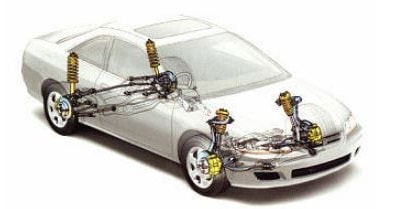
The automobile vehicle’s frame and body are mounted on the front and rear axle not directly but through springs and shock absorbers. This is done to reduce shock transmission from the road. The components that work together to accomplish this are referred to as a suspension system.
Thus, the suspension system includes springs, shock absorbers, and their mountings. The suspension system of a motor vehicle is divided into rear-end suspension and front-end suspension.
Parts of a Suspension System
The following are the main parts of a suspension system:
#1 Springs
The primary purpose of springs is to retain kinetic energy. Their length and material are the primary factors that determine how much energy they can store. There are three basic types of springs that these are: air springs, coil springs, and leaf springs.
#2 Dampers
They transform the kinetic energy held in the springs into thermal energy and are also referred to as shock absorbers.
They are found in the space between the wheels of a car and frame. The lower part of the dampers attaches to the wheels, while the higher part attaches to the vehicle.
#3 Anti-Roll Bar
It is a metal bar that joins the two suspension components and keeps the vehicle from sliding off during turning.
#4 Struts
It is composed of springs and a damper.
Functions of Suspension System
- To prevent the stability of the vehicle in pitching or rolling while in motion.
- To safeguard the occupants from road shocks.
- The suspension system prevents the road shocks from being transferred to the vehicle frame.
- To provide good road holding while driving, cornering, and braking.
- To maintain proper steering geometry.
Types of Suspension System
Following are the types of the suspension system used in vehicles:
- Front End Suspension System
- Rigid axle front suspension.
- Independent front suspension
- Twin I-Beam Suspension System
- Single I-Beam Front Suspension System
- Independent Front End Suspension Using Torsion Bar
- Parallelogram Type Independent Front Suspension
- Struck and Link Type Suspension System
- Trailing Arm Independent Front Suspension
- Sliding Types Suspension System
- Vertical Guide Suspension System
- Rear End Suspension System
- Longitudinal leaf spring rear-end suspension
- Transverse leaf spring rear-end suspension
- Coil spring rear-end suspension
Read also: Rear Axles, Front Axle, and Stub Axle
1. Front End Suspension System
The front-end suspension is more complicated than the rear-end suspension because the front wheels not only move up and down for the car frame but also swing at various angles to the car frame for steering.
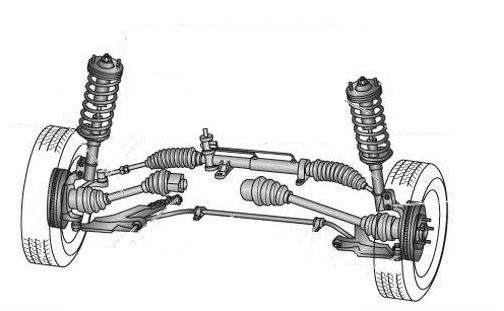
To permit the front wheels to swing to one side or the other for steering, each wheel is ported on a spindle which is part of the steering knuckle. The steering knuckle is then supported through ball joints, by upper and lower control arms which are attached to the car frame.
The Front End Suspensions May Be of Two Types
- Rigid axle front suspension.
- Independent front suspension
1. Rigid Axle Front Suspension
This type of suspension was universally used before the introduction of independent front-wheel suspension. It may use either two longitudinal leaf springs, as shown in the figure, or on transverse spring, usually in conjunction with shock absorbers. These assemblies are mounted similarly to rear leaf spring suspensions.
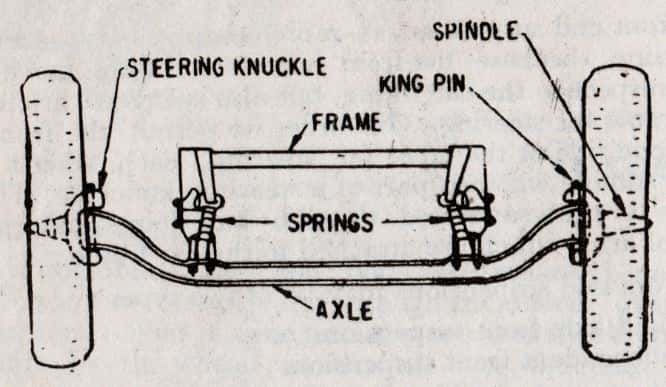
In this type of suspension, the front wheel hubs rotate on antifriction bearings on the steering spindle which are attached to the steering knuckles. To permit the wheels to be turned by the steering gear, the steering spindle and steering knuckle assemblies are hinged on the axle ends.
The pin that forms the pivot of this hinge is usually referred to as the kingpin or steering knuckle pin. Where the forked portion is integral with the steering knuckle and fits over the end of the axle, the construction is known as Reverse Elliot. In Elliot-type construction, the ends of the axle are forked to hold the steering knuckle extension between the ends.
2. Independent Front Suspension
In this type of suspension, each front wheel is independently supported by a coil, torsion bar, or leaf spring. Most of the passenger cars now use the independent front suspension in which the coil spring system is the most common.
Read also: Four Wheel Steering System
Types of Independent Front Suspension
1. Twin I-Beam Suspension System
Different types of front suspension, besides coil spring type, are also in use. The twin I-beam construction is another type, used on some models of Ford trucks. Each front wheel is supported at the end by a separate I-beam.
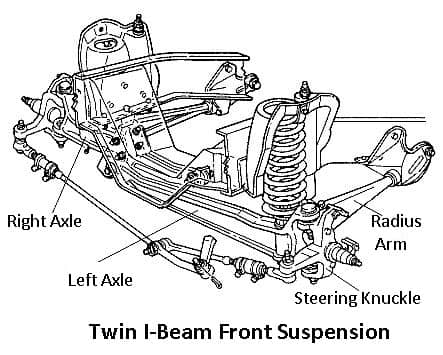
The ends of the I-beams are attached to the frame by pivots. The wheel ends of the two I-beams are attached to the frame by radius arms, which prevent backward or forward movement of the wheels. This type of suspension provides more flexibility.
2. Single I-Beam Front Suspension System
Single I-beam front suspension is employed in larger vehicles. The I-beam has a hole in each end through which a kingpin is assembled to hold the steering knuckle in place. Each end of the I-beam is supported by a leaf spring.
3. Independent Front End Suspension Using Torsion Bar
This type of suspension system, a steel rod, known as a torsion bar, act as a spring to hold the upper and lower control arms parallel under load. The front end of the rod is of hexagonal shape to fit tightly into an opening in the lower control arm.

Its rear reaction is also the hexagonal shape to fit tightly into an opening in an anchor attached to the frame cross member. A seal hides the hexagonally-shaped end of the torsion bar.
The torsion bar gets twisted due to the forces on the wheel assembly’s outer end of the lower control arm. The torsion bar is designed to balance these forces so that the lower arm is kept at a designated height.
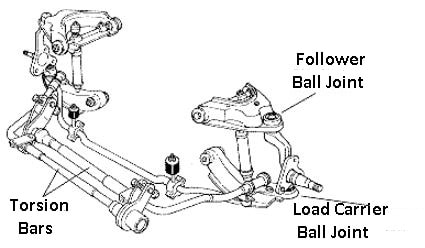
The height can be adjusted by a tightening mechanism at the anchor end which twists the rod using an adjusting bolt and swivel. A strut rod is used to keep the suspension in alignment.
This suspension can protect against road shock causing the lower arm to twist the torsion bar. When the wheels are no longer under stress, the arm returns to normal.
4. Parallelogram Type Independent Front Suspension
The figure shows the simplified diagrams of the independent front suspensions using a coil, torsion bar, and leaf spring. The system is known as parallelogram-type independent front suspension. It consists of an upper and lower link connected by a stub axle carrier.
In general, the lower link is larger than the upper and they may not be parallel. This arrangement maintains the track width as the wheels rise and fall and so minimizes tire wear caused by the wheel scrubbing sideways.
5. Struck and Link Type Suspension System
This type of suspension system is unusual for integral body construction because the loading points are widely spaced. The normal top link is replaced by a flexible, mounting and the telescopic damper acts as the kingpin. This suspension system known as the Mac Pherson System has slight rolling action and absorbs shocks easily.
6. Trailing Arm Independent Front Suspension
Trailing arm independent front suspension maintains constant track and wheel attitude with a slight change in wheelbase and caster angle. A coil spring is attached to the trailing arm which itself is attached to the shaft carrying the wheel hub. When the wheel moves up and down, it winds and unwinds the spring. A torsion bar has also been used in certain designs in place of the coil springs.
7. Sliding Types Suspension System
In this type suspension system, the stub axle can move up and down as well as rotate in the frame members. Track, wheel attitude and wheelbase remain unchanged throughout the rise and fail of the wheel.
8. Vertical Guide Suspension System
In the vertical guide suspension system, the kingpin is attached directly to the cross member of the frame. It can slide up and down, thus compressing and expanding springs.
Coil Spring Front Suspension.
There are 3 types of coil spring front suspension.
1. In the first type, the coil spring is located between the upper and lower control arms. The lower control arm has one point of attachment to the car frame.
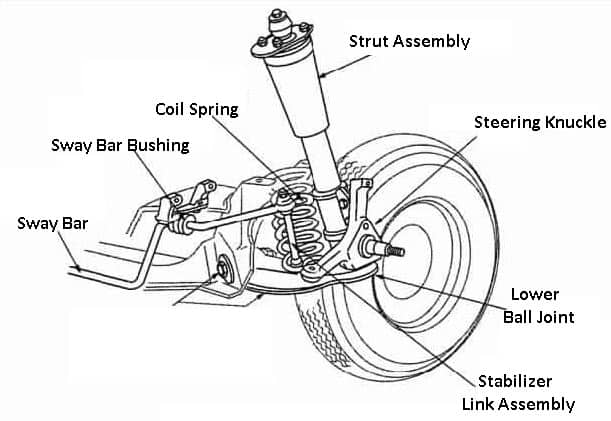
2. In the second type, the coil spring is located between the upper and lower control arms. The lower control arms have two points to the attachment to the car frame.
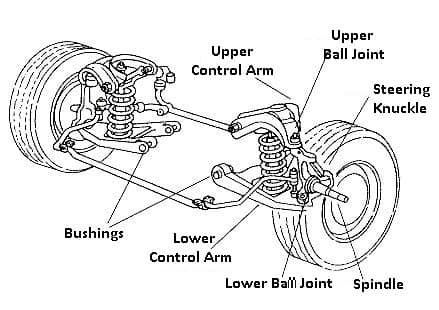
3. In the third type, the coil spring is between the upper control arm and spring tower or housing that is part of front end sheet metal work.
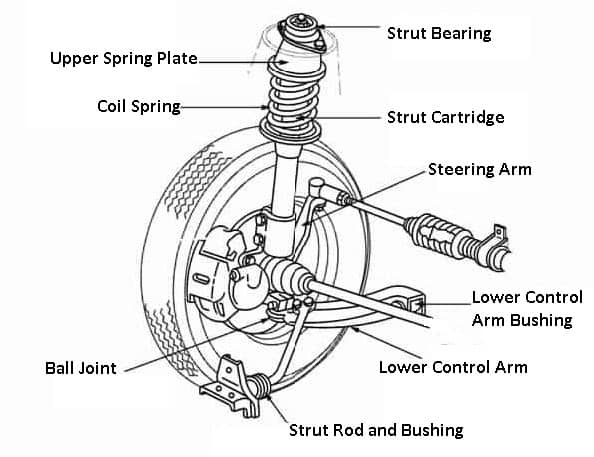
2. Rear End Suspension System
The following are three types of rear-end suspensions generally found in vehicles.
- Longitudinal leaf spring rear-end suspension
- Transverse leaf spring rear-end suspension
- Coil spring rear-end suspension
Longitudinal and Transverse Leaf Spring Rear End Suspension
Longitudinal leaf springs and coil spring rear-end suspensions are widely used in modern vehicles. Transverse leaf spring rear-end suspension is used in conjunction with the Hotchkiss drive, the leaf springs must be made strong and resilient enough to transmit the driving thrust and torque to resist sideways, in addition, to holding the spring weight of the body.

The spring weight is kept as less as possible, to improve the side of the vehicle. Because the springs do not generally support the wheels, rims, tires, brakes, and rear axles, the weight of these parts is called the spring weight. The spring is clamped to the rear-axle housing by U-bolts, and its every end is pivoted to the frame, using eyes formed at the ends of the longest leaf.
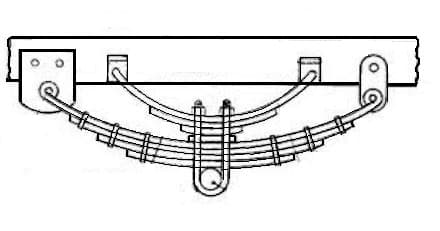
One end of the longleaf is secured to the front hanger by a bolt and the other end to the rear hanger by spring shackles. Both the hangers are bolted to the frame. The spring elongates in compression and shortens in expansion. This change in the length of the spring is compensated by a shackle.
At the middle position of the spring length, the rebound clips are placed. They are loose enough to permit the leaves to slide on the other, and yet tight enough to permit the leaves together when the spring rebounds. The spring eyes are usually provided with bushings or some anti-friction material, such as bronze or rubber.
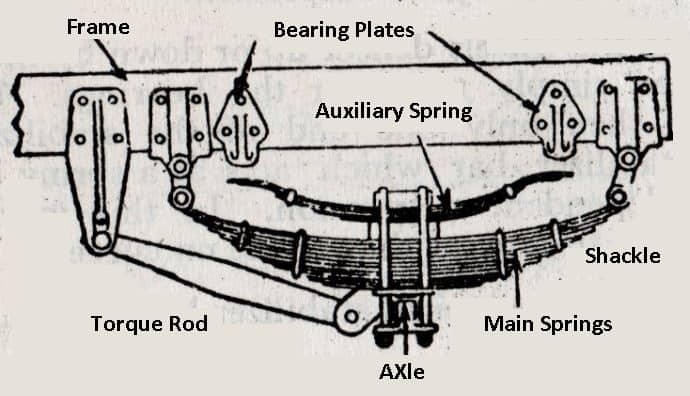
The figure shows a heavy-duty truck rear end suspension with leaf type auxiliary springs and torque rods. This type of suspension is used in truck intended for more severe operations and with rear axle loading exceeding 10000 kg. The figure shows rear-end suspension of a car with Hotchkiss drive.
Coil Spring Rear End Suspension
The figure shows coil spring rear end suspension. This type of suspension is always used in conjunction with torque tube, torque reaction link, or torque rod drive. Therefore the coil springs are not subjected to driving thrust or twist.
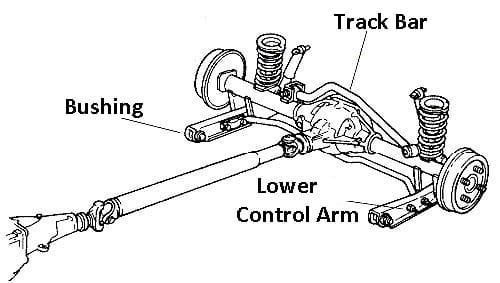
Stabilizers and radius rods are also used which relieve the coil springs of all stresses except those acting in a vertical direction. The stabilizer prevents excessive roll or sideways when the car is concerning.
The radius rod keeps the rear axle and frame in lateral alignment. The coil springs are seated in pan-shaped brackets spring seats attached to the rear axle.
De-Dion and Independent Type Coil Spring Rear End Suspensions
The figure shows De-Dion and independent type coil spring rear end suspensions. At (A), the rigid De-Dion tube is located longitudinally by two parallel links and laterally by a watt linkage. The tube maintains the track at a constant width.
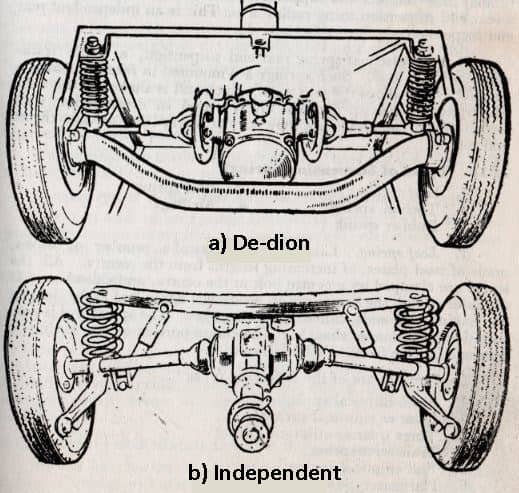
It is to be noted that De-Dion suspension is not an independent suspension because a tubular axle connects and supports both the wheels. At (B) is shown a rear-end suspension using the radius arm. This is an independent rear end suspension.
In traverse leaf spring rear end suspension, a single transverse spring is used. Such springs are mounted in an inverted position parallel to and above the rear axle. Each end is shaken to the axle.
The transverse rear springs are always used in combination with torque-tube drive, and hence they do not carry the driving thrust and torque.
Requirements of a Suspension System
- Minimum deflection is consistent with required stability.
- Comparability with other vehicle components-type, frame wheelbase, steering linkage.
- Minimum wheel hop.
- Low maintenance and operating costs.
- Low initial cost.
- Minimum weight
- Minimum wear.
Read also: What is a steering system? and how it works? [The complete guide]
That’s it, Thanks for reading. If you like this article on “types of suspension system” please share it with your friends. If you have any questions you can ask in the comments below.
Subscribe to our newsletter to get notification of our new posts
Download Pdf of this article
Referances:
- https://en.wikipedia.org/wiki/Car_suspension
- https://gomechanic.in/blog/car-suspension-explained/
- https://www.carsguide.com.au/car-advice/
FAQs
A suspension is a damped spring that produces opposing forces when compressed. Springs support the weight of the car. Dampers prevent spring movement, absorbing energy and preventing them from bouncing uncontrollably.
The suspension system generally consists of springs, wheels, shock absorbers, rods, joints, bearings, busing, and frame.
send me the PDF
The PDF file has been sent to your inbox.
plis send me pdf
The PDF file has been sent to your inbox.
🙏 send me a pdf
The PDF file has been sent to your inbox.
please send pdf
The PDF file has been sent to your inbox.
Please send the pdf
The PDF file has been sent to your inbox.
Please I need the pdf in my mail box
The PDF file has been sent to your inbox.
Pls send me pdf
The PDF file has been sent to your inbox.
hello, how do i access the pdf of this write up? thanx
The PDF file has been sent to your inbox. You’re welcome.
I would like a copy of the pdf.
The PDF file has been sent to your inbox.
Please send pdf file. Thanks in advance.
The PDF file has been sent to your inbox. You’re welcome.
Thanks everyone
You’re welcome.
The post you wrote is very simple to read in a way that even a non automotive guy can understand the types of suspension systems in cars.
I’m glad you liked our written. Keep visiting.
very nice post.
Thanks for reading.
Please send pdf
The PDF file has been sent to your inbox.
Send me the pdf pls
TiA
The PDF file has been sent to your inbox.
Hi very interested i Like you can Send Full Details Thank you
The PDF file has been sent to your inbox.
Thank you
You’re welcome.
Thanks
You’re welcome.
This PDF was helpful thank you
You’re welcome.
Very detailed. kindly share a copy on
[email protected]
The PDF file has been sent to your inbox.
Please send IT to me at [email protected]
Tkanki you
You’re welcome. The PDF file has been sent to your inbox.
Hi
Please send the pdf on my email address
Thanking you in advance
Regards
You’re welcome. The PDF file has been sent to your inbox.
Please send me on – [email protected]
The PDF file has been sent to your inbox.
Can you please share with me the suspension pdf
The PDF file has been sent to your inbox.
I would like a copy of your pdf sent to me: [email protected]
The PDF file has been sent to your inbox.
Great, i would like to have a pdf
The PDF file has been sent to your inbox.
Very descriptive plz drop me the pdf
The PDF file has been sent to your inbox.
Pls send me also
The PDF file has been sent to your inbox.
Kindly send me a PDF for this article.
The PDF file has been sent to your inbox.
Very good presentation i learn much. Thank you
It has been a privilege that you have this presentation, my students really appreciated the way the information was given. Once again thank you and MABUHAY.
You’re most welcome.
You’re welcome.
Thanks for the info
You’re welcome.
It’s good
Thank You
That is good so well done
Good
Thanks